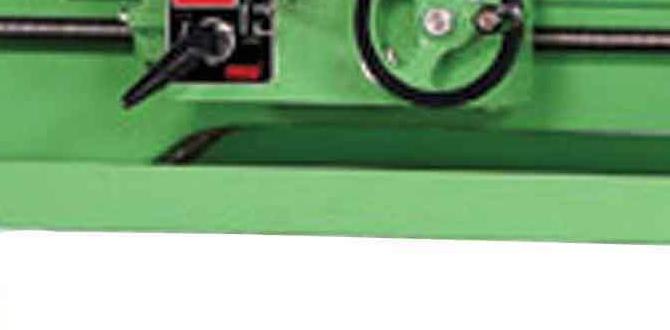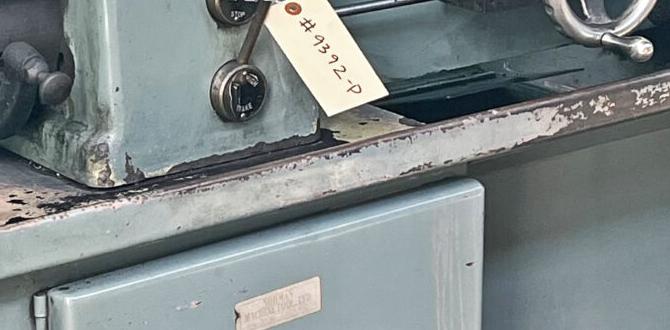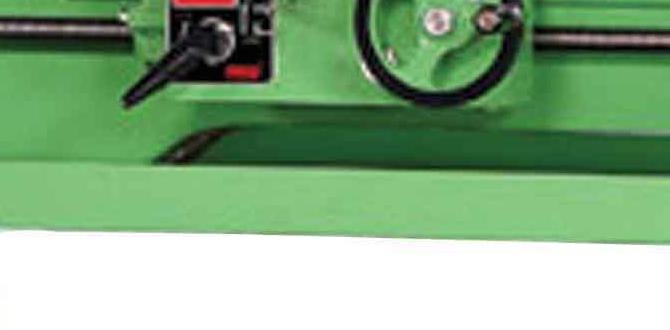Quick Summary:
Looking for a DIY wood lathe dust extraction system? Building your own is a smart, cost-effective way to significantly improve workshop air quality. This guide shows you how to create an efficient system that captures wood dust right at the source, protecting your health and keeping your workspace cleaner.
DIY Wood Lathe Dust Extraction System: Proven Efficiencies for Your Workshop
Working with a wood lathe is incredibly rewarding, allowing you to shape beautiful pieces of wood. However, it also creates a lot of fine dust. This dust isn’t just messy; it can be harmful to your lungs and make your woodworking environment unpleasant. Don’t worry, though! Building a DIY wood lathe dust extraction system is more achievable than you might think. It’s a fantastic project that dramatically improves your workshop’s air quality. We’ll walk through how to create an effective system that tackles dust right where it’s made, keeping your lungs clear and your workspace tidy. Get ready to breathe easier!
Why a Dust Extraction System is a Woodturner’s Best Friend
Woodturning produces a lot of airborne particles, from fine wood powder to larger chips. Without a proper capture system, this dust can:
Impact Your Health: Inhaling fine wood dust over time can lead to respiratory issues, allergies, and even more serious conditions. Organizations like the Occupational Safety and Health Administration (OSHA) highlight the importance of controlling dust exposure in workplaces.
Make a Mess: Wood dust infiltrates every corner of your workshop, coating tools, surfaces, and your clothes. Cleanup becomes a constant battle.
Reduce Visibility: A cloud of dust can obscure your work area, making it harder to see what you’re doing and potentially leading to mistakes or safety hazards.
Damage Equipment: Fine dust can get into the moving parts of your lathe and other tools, causing wear and tear and reducing their lifespan.
A well-designed dust extraction system captures dust as it’s generated, preventing it from becoming airborne and creating a much safer and cleaner working environment.
Understanding the Fundamentals: How Dust Extraction Works
At its core, a dust extraction system relies on airflow created by a fan or blower. This airflow is directed through a duct or hose to the point where dust is produced. The moving air carries the dust particles along the duct and into a collection point, usually a dust bin or a filtration system.
Key components typically include:
Dust Collector/Shop Vac: The heart of the system, providing the suction power.
Ducting/Hoses: Channels to move the air and dust.
Collector Device: Where the dust is stored (e.g., a simple bin, bag filter, or cyclone separator).
Capture Hood: A specially designed nozzle placed near the dust source.
For a wood lathe, the goal is to position the capture hood as close as possible to the spinning workpiece to grab dust and chips before they fly off.
Designing Your DIY Wood Lathe Dust Extraction System
The beauty of a DIY system is that you can tailor it to your specific lathe, workshop space, and budget. Here’s a breakdown of common approaches and considerations:
Choosing Your Suction Source
You have a few main options for the “engine” of your dust collection:
1. Shop Vacuum (Wet/Dry Vac):
Pros: Readily available, relatively inexpensive, good suction for smaller shops and light dust loads. Often have built-in filters.
Cons: Can become clogged quickly with fine dust, filter performance degrades as it fills, might struggle with larger chips, can be noisy. The bag or canister needs frequent emptying.
2. Dedicated Dust Collector:
Pros: Designed specifically for wood dust, generally provide higher airflow and static pressure, better at moving larger volumes of dust and chips, often use finer filters or cyclone separation for more efficient collection.
Cons: More expensive than a shop vac, requires dedicated space, can be bulky.
3. DIY Fan System:
Pros: Potentially the cheapest option if you have access to parts (e.g., a strong industrial fan). Highly customizable.
Cons: Requires careful engineering to ensure sufficient airflow and filtration, can be noisy, might not be as effective as commercial units for finer dust.
For beginners, a good quality shop vacuum is often the most practical starting point. Many woodturners find success by simply attaching a hose from their shop vac to a custom-made dust hood.
The Crucial Capture Hood Design
This is where the magic happens for lathe dust collection. The hood needs to:
Be close to the work: The closer, the more dust it captures.
Direct airflow effectively: Guide the dust-laden air towards the hose.
Not interfere with your work: Allow you clear access to the lathe and workpiece.
Here are a few popular DIY hood designs:
Simple Hose Attachment: The most basic. Just tape or clamp the end of your shop vac hose near the back of the tool rest or cutting area. It’s better than nothing but not very efficient.
Gooseneck/Flexible Arm Hood: A flexible metal arm (like those used for welding or lamps) with a specially shaped nozzle at the end. The arm allows you to position the hood precisely. The nozzle can be made from PVC pipe fittings, sheet metal, or even 3D printed.
Tool Rest Hood: Integrate a dust port directly into your lathe’s tool rest. This is a more permanent and efficient solution. You can often find plans online to modify existing steel tool rests or build one from scratch.
Bench-Mounted Hood: A hood that attaches to a stand or bench behind the lathe, designed to catch dust thrown backward.
Materials for Hoods: Common materials include PVC pipe fittings, ABS plastic, thin plywood, sheet metal, and even repurposed plastic containers.

Ducting and Hose Selection
The type of ducting you use impacts airflow.
Hose Type:
Smooth Interior Hoses: Like those made for dust collectors or vacuum cleaner hoses, offer less resistance to airflow than ribbed hoses.
Ribbed Hoses: Cheaper and more flexible but create more turbulence and drag, reducing overall suction.
Hose Diameter: Larger diameters generally move more air with less velocity and static pressure loss. For a typical shop vac, 2.5-inch or 3-inch diameter hoses are common.
Ducting Material: Flexible dust collection hose is best. If you need rigid runs, PVC pipe can be used, but flexible hose is usually preferred for reach and maneuverability around the lathe.
Tip: Keep hose runs as short and straight as possible to maximize suction at the hood. Use smooth, sweeping bends rather than sharp 90-degree elbows.
Filtration and Air Cleaners
While your primary goal is to capture dust at the source with your hood, a secondary air cleaner can be a great addition for any remaining airborne particles. These units typically use a fan to pull air through a series of filters (often a pre-filter and a HEPA filter) and recirculate clean air back into the workshop. Many affordable options are available, or you can find DIY plans online using furnace filters and a fan.
A good resource for understanding dust control in woodworking is the Woodworking for Everyone website, which offers extensive information on best practices.
Building Your System: A Step-by-Step Guide (Using a Shop Vac)
This guide focuses on a practical approach using a shop vacuum and a simple, adaptable hood.
Step 1: Gather Your Materials and Tools
Here’s a list to get you started. Adapt it based on your chosen design and what you have available.
Materials:
Shop Vacuum (preferably with a reusable filter bag or canister and good suction)
Flexible dust collection hose (e.g., 2.5″ or 3″ diameter, about 6-10 feet long)
Hose clamps (to secure hose to fittings and vacuum adapter)
Materials for your dust hood. Common options:
PVC fittings (e.g., elbows, couplings, reducers – size to match your hose)
Thin plywood or MDF (for flat panels)
Sheet metal (optional, for more durable hoods)
Duct tape or strong construction adhesive
Mounting hardware (screws, brackets, wing nuts for adjustability)
Optional: A shop vac adapter to connect your hose securely.
Tools:
Measuring tape
Pencil or marker
Saw (jigsaw, handsaw, or table saw for cutting wood/plastic)
Drill with various bits
Screwdriver
Utility knife or shears for cutting hose
Safety glasses
Dust mask (even with dust collection, protect yourself during setup!)
Optional: Hot glue gun, 3D printer (if making custom parts)
Step 2: Design and Construct Your Dust Hood
Let’s aim for a versatile hood that can be attached to your tool rest or a separate arm.
1. Decide on a shape: A simple box with an angled opening or a rounded form often works well. The key is creating a funnel effect towards the hose.
2. Cut your components:
If using PVC: Select elbows and couplings that fit your hose diameter. You might use a 90-degree elbow as the primary capturing point.
If using wood/plastic: Cut panels to form a basic box or cone shape. Ensure one end has an opening to connect your hose.
3. Create the hose connection:
If using PVC fittings, this is straightforward. Connect a reducer or elbow where your hose will attach.
If using wood/plastic, drill a hole sized for your hose or a PVC fitting.
4. Shape the dust entry: Angle the opening of your hood to face the workpiece. For a PVC elbow, this is already done. For a wooden hood, you might cut an opening at an angle.
5. Assemble the hood: Use screws, adhesive, or duct tape to join the pieces. Ensure it’s reasonably airtight, as leaks reduce suction.
Example using PVC: Connect a 2.5″ elbow (for the dust intake) via a short section of pipe to a 2.5″ to 1.5″ reducer (if your shop vac hose is 1.5″). Secure with adhesive or screws if needed.
6. Consider mounting: How will you attach this to your lathe?
Tool Rest Clamp: Fashion a clamp mechanism from metal strips or wood that can grab your steel tool rest.
Flexible Arm: Use a gooseneck lamp arm, articulating arm, or even a simple rigid rod with adjustable joints. Mount one end to your hood and the other to a stable part of the lathe or a nearby workbench.
Bolting: Drill holes in a piece of plywood and bolt the hood to it. This plywood piece can then be clamped to a tool rest or other fixture.
Pro Tip for Hoods: Start with a simple design. You can always refine it later based on how well it works!
Step 3: Connect the Hose to the Shop Vac
Most shop vacs come with a hose adapter. If yours is missing or doesn’t fit your dust collection hose well, you can often find universal adapters, or create one from PVC fittings or even thick cardboard and plenty of duct tape.
1. Attach the adapter: Connect the shop vac adapter to the end of your hose.
2. Secure with clamps: Use hose clamps to ensure a tight, leak-proof seal between the hose and the adapter. This is critical for maintaining suction.
3. Connect to the vacuum: Attach the other end of the hose to the intake port on your shop vacuum. Use another clamp if necessary.

Step 4: Position and Test Your System
Now for the exciting part!
1. Mount the hood: Attach your dust hood according to your chosen mounting method.
2. Adjust position: Once mounted, adjust the hood so it’s as close as possible to the area where dust and chips are generated, usually the back of the tool rest where the cutting tool is making contact. Ensure it doesn’t interfere with your ability to maneuver the tool.
3. Turn on the shop vac: Start the vacuum. You should feel significant airflow at the hood opening.
4. Test with wood: Turn on your lathe and make a simple cut. Observe how much dust is being captured by the hood. Adjust the hood’s position for optimal collection.
5. Listen and feel: You should hear and feel the dust and chips being pulled into the hose.
Troubleshooting:
Low Suction: Check for leaks in the hose connections, cracks in the hood, or a clogged vacuum filter. Ensure the hose isn’t kinked.
Dust Escaping: The hood might be too far away, not angled correctly, or your airflow isn’t strong enough for the type of cut. Try a smaller workpiece or less aggressive cuts.
Optimizing Your System for Proven Efficiencies
Simply having a system isn’t enough; making it work efficiently is key.
Table 1: Lathe Dust Extraction Efficiency Factors
| Factor | Impact on Efficiency | How to Optimize |
| :—————— | :————————————————————————————————————————— | :—————————————————————————————————————————————– |
| Airflow (CFM) | Higher airflow captures more dust, especially larger chips. | Use a shop vac/dust collector with adequate CFM for your lathe size. Keep duct runs short and smooth. Use larger diameter hoses if possible. |
| Static Pressure | The “pulling power” to overcome resistance in hoses and filters. Crucial for capturing dust far from the source. | Avoid restrictive filters. Minimize bends and obstructions in ducting. Ensure hose connections are airtight. |
| Capture Hood Design | Directly impacts how much dust is caught before it disperses. | Keep it close to the cutting source. Optimize opening size and shape to funnel dust efficiently. |
| Hose Length & Smoothness | Long, ribbed hoses create resistance and reduce effective suction. | Use the shortest, smoothest hose possible. Avoid sharp bends; use sweeping curves. |
| Dust Collector Type | Different collectors are suited for different dust loads and particle sizes. | Match collector power to your typical woodworking task. Consider a cyclone pre-separator for very dusty operations. |
| Filter Efficiency | Clogged or low-efficiency filters reduce airflow and don’t capture fine particles well. | Clean or replace filters regularly. Use appropriately rated filters (e.g., MERV 13 or HEPA for fine dust) if your system allows. |
Table 2: Common DIY Hood Designs and Considerations
| Hood Type | Materials | Pros | Cons | Best For |
| :——————- | :—————————————- | :————————————————————————— | :——————————————————————— | :————————————————————————- |
| Tool Rest Integrated | Steel tube, PVC, sheet metal, bolts | Permanent, excellent dust proximity | Requires modification/fabrication, may not fit all tool rests | Dedicated lathes, users comfortable with metal fabrication |
| Flexible Arm Mount | Gooseneck arm, PVC fittings, wood, ABS | Highly adjustable, easy to reposition, versatile | Arm can sag, can be more expensive than fixed hoods | Lathing different sized pieces, various cutting operations |
| Simple Pipe Elbow | Large PVC elbow, short pipe, hose clamp | Very simple, cheap, quick to make | Limited adjustability, may not fully enclose dust, can be obtrusive | Light dust situations, temporary setup, users on a tight budget |
| 3D Printed | Filament (PLA, PETG, ABS) | Can create complex, optimized shapes, easy iteration | Requires a 3D printer, can be brittle depending on material | Users with 3D printing capabilities, custom/ergonomic designs |
Best Practices for Maximum Efficiency:
Wood Type Matters: Softer woods produce larger chips that are easier to capture. Hardwoods and exotics create finer dust that is much harder to control and more dangerous. Your system needs to be robust for these.
Cutting Technique: Make slower, controlled cuts. Avoid aggressive cuts that throw chips violently. This reduces the amount of dust that escapes your capture zone.
Regular Maintenance: Empty your shop vac or dust collector bag frequently. Clean or replace filters according to the manufacturer’s recommendations. A clogged filter is a major airflow killer.
Hose Management: Keep hoses tidy and out of the way. A dangling hose can be a tripping hazard or get caught in the spinning workpiece. Use bungee cords or hose hangers.
Shop Air Cleaners: As mentioned, a secondary air cleaner is vital for capturing the fine dust that inevitably escapes. Run it continuously during and after turning sessions. The U.S. Environmental Protection Agency (EPA) provides valuable information on indoor air quality and pollution control that applies here: EPA Indoor Air Quality.




